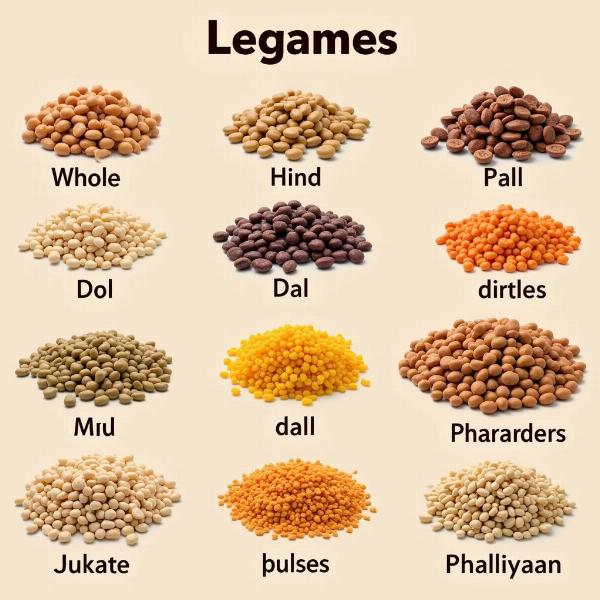Legumes, a staple in many Indian diets, are often discussed but their Hindi meaning can sometimes be confusing. Understanding the “hindi meaning of legumes” is key to navigating recipes, dietary discussions, and even agricultural information in Hindi. This article will delve into the various Hindi words for legumes, exploring their nuances and cultural context.
Decoding “Dal” and Beyond: Hindi Words for Legumes
While “dal” is often used synonymously with legumes, it technically refers to the split version of pulses. Pulses themselves are the edible seeds of leguminous plants. So, while all dal are derived from pulses, not all pulses are dal. This distinction is crucial when understanding the hindi meaning of legumes.
- Dal (दाल): As mentioned, this is the most common term and refers to split pulses like masoor dal (red lentils), chana dal (split chickpeas), and toor dal (split pigeon peas).
- Pulses (दालें – Dalen – plural of Dal): This broader term encompasses the whole, unsplit seeds of leguminous plants. Think of whole masoor, chana, or rajma (kidney beans).
- Shimbiyaan (शिमबियाँ): This is a more general Hindi word for legumes, encompassing both pulses and the broader family of leguminous plants, including those used for their pods like green beans.
- Phalliyaan (फलियाँ): This word specifically refers to the pods of leguminous plants, like green beans or peas in their pods.
 Hindi Words for Different Types of Legumes
Hindi Words for Different Types of Legumes
Navigating Regional Variations in Hindi Names for Legumes
Just as with any language, regional variations exist within Hindi when it comes to naming legumes. For example, what might be called “lobia” in one part of India could be known as “chawli” in another. These variations add richness to the language but can also create some confusion.
- Examples of Regional Variations: The word for black-eyed peas can vary from “lobhiya” to “rongi” depending on the region. Similarly, green gram can be referred to as “moong” or “mung.”
- Importance of Context: Understanding the context of the conversation is key to deciphering the intended meaning. If you are unsure, it’s always best to clarify.
Legumes in Indian Cuisine and Culture
Legumes are not just a food source in India; they are deeply intertwined with the culture. They play a central role in religious ceremonies, festivals, and everyday meals.
- Religious Significance: Certain legumes are offered as prasad during religious ceremonies. For example, chana dal is often used in offerings to Lord Ganesha.
- Festivals: Legumes are essential ingredients in festive dishes. Think of the rich and flavorful moong dal halwa prepared during Diwali.
- Everyday Meals: Dal is a staple in most Indian households, served with rice, roti, or other breads.
Why Knowing the Hindi Meaning of Legumes is Important
Understanding the nuances of Hindi words for legumes goes beyond just vocabulary. It allows for a deeper appreciation of Indian cuisine, culture, and agricultural practices.
- Connecting with Culture: Knowing the correct Hindi terminology allows you to engage more meaningfully with Indian culture, particularly when discussing food and traditions.
- Accurate Communication: Whether you are discussing a recipe or agricultural practices, using the precise Hindi terms avoids misunderstandings.
What are some common legumes consumed in India?
Some common legumes consumed in India include chana (chickpeas), toor (pigeon peas), masoor (red lentils), moong (green gram), urad (black gram), and rajma (kidney beans).
Are all dals the same?
No, not all dals are the same. They differ in taste, texture, and nutritional content. Each type of dal lends a unique flavor and texture to dishes.
How are legumes beneficial for health?
Legumes are packed with protein, fiber, and various vitamins and minerals, contributing to a healthy diet. They are known to aid digestion, regulate blood sugar levels, and promote heart health.
Conclusion
The “hindi meaning of legumes” is a multifaceted topic that extends beyond simple translation. From the everyday “dal” to the broader “shimbiyaan,” each word carries its own nuances and cultural context. Understanding these terms enriches our understanding of Indian cuisine, culture, and the vital role legumes play in them. By grasping the intricacies of these Hindi words, we can communicate more effectively and connect more deeply with the rich tapestry of Indian traditions.
Expert Insights:
- Dr. Anjali Sharma, Nutritionist: “Legumes are an integral part of a balanced Indian diet. Their high protein and fiber content makes them essential for overall health.”
- Chef Vikram Singh: “Understanding the different types of dal and their unique characteristics is crucial for creating authentic and flavorful Indian dishes.”
Frequently Asked Questions (FAQ):
- What is the Hindi word for lentils? The Hindi word for lentils is “masoor (मसूर).” Split red lentils are called “masoor dal.”
- Is rajma a legume? Yes, rajma (kidney beans) is a type of legume.
- What is the difference between dal and pulses? Dal refers to split pulses, while pulses refer to the whole, unsplit seeds.
- Are legumes good for vegetarians? Yes, legumes are an excellent source of protein for vegetarians.
- What is the Hindi word for chickpeas? The Hindi word for chickpeas is “chana (चना).”
- What are some common dishes made with legumes in India? Dal tadka, sambar, chole, rajma chawal, and moong dal halwa are some popular dishes made with legumes in India.
- Where can I learn more about Indian cuisine? Explore our other articles on Meaning-Hindi.in for more insights into Indian cuisine and culture.
Meaning-Hindi.in is your trusted partner for all your Hindi translation needs. We offer a comprehensive range of services, from business and legal document translation to website localization and technical manual translation. Our expert team ensures accurate and culturally sensitive translations, helping you bridge the communication gap effectively. Whether you need to translate marketing materials, legal contracts, or educational content, Meaning-Hindi.in can provide high-quality translations tailored to your specific needs. Contact us today at [email protected] or call us at +91 11-4502-7584 to discuss your translation requirements. Meaning-Hindi.in – Your gateway to accurate and reliable Hindi translations.